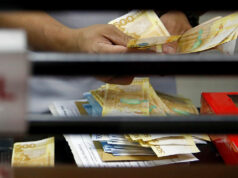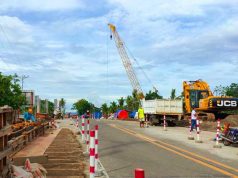Government starts second half with increased spending and revenues

STATE SPENDING picked up at a “decent” pace in July, turning around from a contraction in June, according to data the Treasury bureau released on Friday that also showed the second straight month that the national government incurred a budget deficit.
State spending picked up by 3.43% to P339.4 billion in July from P328.1 billion a year ago, although primary expenditures — or net of interest payments — edged up by just 1.81% to P288.4 billion from P283.3 billion. Still, that was a turnaround from a 3.06% drop in primary expenditures, which include infrastructure disbursements, in June. Interest payments increased by 13.66% to P51 billion from P44.8 billion.
Revenues increased by 9.5% to P264.1 billion in July from P241.7 billion a year ago, fueled by an 8.81% rise in tax collections to P236.9 billion from P217.7 billion. The Bureau of Internal Revenue (BIR) accounted for 76.1% of tax collections and 68.27% of total revenues with P180.3 billion in July, 9.96% bigger than the year-ago P164 billion. The Bureau of Customs, which contributed 23.05% to tax collections and 20.67% of total revenues, increased its take by 4.79% to P56.6 billion from P52.1 billion. Other state revenue collectors grew take by 22.35% to P1.9 billion from P1.6 billion.
Non-tax revenues — mainly state subsidies to cover taxes on government transactions — increased by 13.15% to P27.2 billion from P24 billion, with Treasury collections rising by 22.14% to P14.4 billion from P11.8 billion. “The growth is driven mainly by higher income from national government (NG) deposits, investment from the Bond Singking Fund, guarantee fees and NG share from Philippine Amusement and Gaming Corp. income,” the Treasury said in a statement. Other non-tax revenues — including privatization proceeds as well as fees and charges — contributed P12.8 billion, 4.54% more than the year-ago P12.3 billion.
Revenue and expenditure performance resulted in a P75.3-billion fiscal deficit as of July that was 12.83% smaller than the P86.4 billion recorded in last year’s first seven months.
The government operated on a reenacted 2018 budget from January to April 15, when Mr. Duterte signed this year’s national budget into law four months late, but vetoed P95.3 billion in funds that were not in sync with state priorities, slashing the total to P3.662 trillion.
“The government begins the first month of the second half on the right foot, showing a decent pickup in expenditure 3.4% while revenue collection remained strong at 9.3%,” Nicholas Antonio T. Mapa, senior economist at ING Bank N.V. Manila Branch, told reporters in an e-mail.
“With the budget back online, government expenditures were up 23% from June and 3.4% up from the July 2018’s spending spree where NG spending was up 34%. With the administration looking to chase six percent growth for 2019, the July numbers mirror the stark drawdown in the funds parked with the BSP with the Treasury Single Account seeing a decrease of roughly P100 billion,” he added.
The economy grew by a disappointing 5.5% last semester against this year’s 6-7% goal, a performance blamed largely on the four-month delay in budget enactment that aggravated the impact of the 45-day public works ban ahead of the May 13 midterm polls.
“Government spending (or lack of it) was tagged as one of the culprits for the speed bump that the Philippines hit in first half and, so far, it looks like the government is hell bent on rolling out the funding to help nudge growth in the right direction. With the BSP easing policy (and projected to cut further) to revive investment, it looks like we will need a concerted effort to get second-half growth to 6.4%, good enough to carry the Philippines past the six percent finish line by year end.”
The seven months to July still saw the government spending 0.11% less at P1.93 trillion from P1.932 trillion a year ago, with primary spending still contracting by 1.32% to P1.699 trillion from P1.721 trillion and interest payments growing by 9.83% to P231 billion from P210.3 billion. The Treasury noted that state spending was still “being weighed down by the delayed approval of the 2019 budget, coupled with the election ban on new public works”.
For Ruben Carlo O. Asuncion, chief economist of UnionBank of the Philippines, Inc., “It is a consolation that spending in July is higher year-on-year.”
“However, the national treasury is right in saying that the budget implementation delay is still weighing down on government spending. We wish that this was not the case, but it is what it is,” Mr. Asuncion said in an e-mailed response to questions.
“On a positive note, it is just the first month of the third quarter and spending catch-up, I am sure, is rolling.”
Moody’s Investors Service — which earlier this month cut its Philippine economic growth projection further to 5.8% this year from the six percent it gave at the end of May and from the 6.2% in had penciled in February in the face of delayed budget enactment and the resulting disappointing 5.5% first-half expansion — said in an e-mail on Friday that “while the Philippines is not immune from the downturn in external trade, we view domestic factors as more important.”
“For example, the sharp deceleration in growth in the first half of the year was largely due to the delay in the budget; other countries in the region also saw their economies slow to a similar magnitude, but these were clearly more linked to the downturn in their export sector, said Christian de Guzman, senior vice-president of Moody’s Sovereign Risk Group.
“As such, the extent to which the government can execute its catch-up plan for budgetary disbursements, especially for infrastructure, will determine the extent to which fiscal expenditure can act as a buffer against external headwinds.”
Revenues increased by 9.64% to P1.812 trillion year-to-date from P1.652 trillion, with tax collections growing by 9.87% to P1.618 trillion from P1.472 trillion. The BIR collected 10.47% more at P1.247 trillion, compared to P1.129 trillion a year ago, while Customs grew collections by 7.88% to P357.7 billion from P331.5 billion. Other state tax collectors grew take by 8.58% to P13.5 billion from P12.4 billion.
Non-tax revenues grew 7.78% to P193.8 billion year-to-date from P179.8 billion the past year, with the Treasury contributing P102 billion that was 30.92% more than the year-ago P77.9 billion, while other offices saw collections cut by 9.91% to P91.8 billion from P191.9 billion.
The resulting fiscal balance was a P117.9-billion year-to-date deficit that was 57.79% smaller than the year-ago P279.4 billion. — Beatrice M. Laforga



